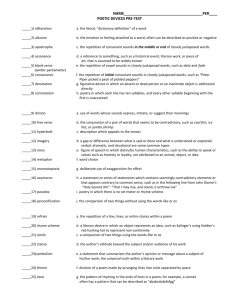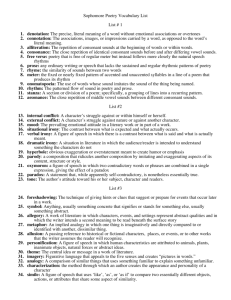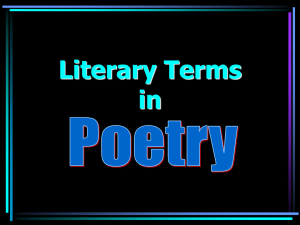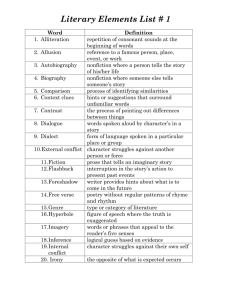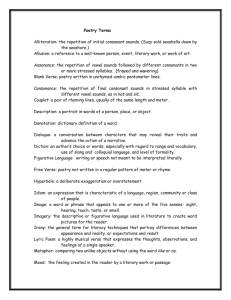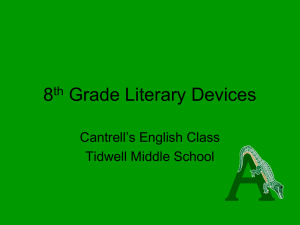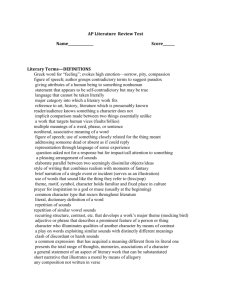12th Grade Poetry Terms Pre-Test
advertisement
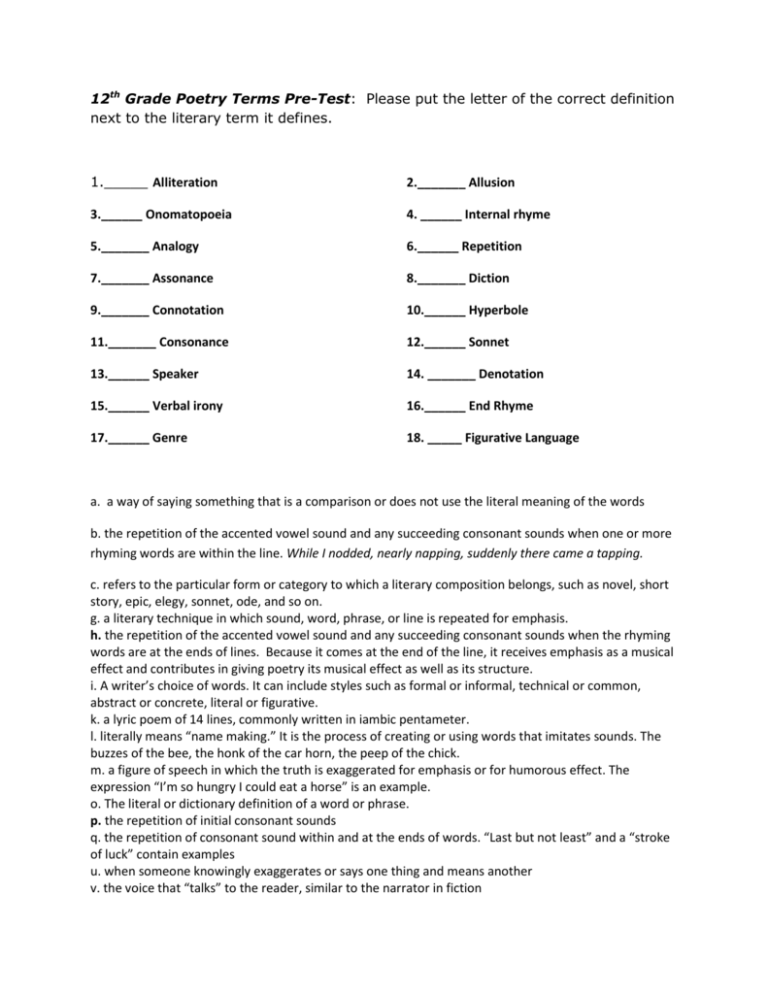
12th Grade Poetry Terms Pre-Test: Please put the letter of the correct definition next to the literary term it defines. 1._____ Alliteration 2._______ Allusion 3.______ Onomatopoeia 4. ______ Internal rhyme 5._______ Analogy 6.______ Repetition 7._______ Assonance 8._______ Diction 9._______ Connotation 10.______ Hyperbole 11._______ Consonance 12.______ Sonnet 13.______ Speaker 14. _______ Denotation 15.______ Verbal irony 16.______ End Rhyme 17.______ Genre 18. _____ Figurative Language a. a way of saying something that is a comparison or does not use the literal meaning of the words b. the repetition of the accented vowel sound and any succeeding consonant sounds when one or more rhyming words are within the line. While I nodded, nearly napping, suddenly there came a tapping. c. refers to the particular form or category to which a literary composition belongs, such as novel, short story, epic, elegy, sonnet, ode, and so on. g. a literary technique in which sound, word, phrase, or line is repeated for emphasis. h. the repetition of the accented vowel sound and any succeeding consonant sounds when the rhyming words are at the ends of lines. Because it comes at the end of the line, it receives emphasis as a musical effect and contributes in giving poetry its musical effect as well as its structure. i. A writer’s choice of words. It can include styles such as formal or informal, technical or common, abstract or concrete, literal or figurative. k. a lyric poem of 14 lines, commonly written in iambic pentameter. l. literally means “name making.” It is the process of creating or using words that imitates sounds. The buzzes of the bee, the honk of the car horn, the peep of the chick. m. a figure of speech in which the truth is exaggerated for emphasis or for humorous effect. The expression “I’m so hungry I could eat a horse” is an example. o. The literal or dictionary definition of a word or phrase. p. the repetition of initial consonant sounds q. the repetition of consonant sound within and at the ends of words. “Last but not least” and a “stroke of luck” contain examples u. when someone knowingly exaggerates or says one thing and means another v. the voice that “talks” to the reader, similar to the narrator in fiction w. an indirect reference to a historical or literary person, place, thing, or event with which the reader is assumed to be familiar. x. a point-by-point comparison between two things that are alike in some respect. z. the emotional response evoked by a word. AA. the repetition of a vowel sound within non-rhyming words. Helter-skelter, sweet dreams, and high and mighty are examples. Just to check: 1. 2. 3. 4. 5. 6. 7. ___Surrealism __ Frame Story ___ Hamartia ___ Magical realism ___Romanticism ___ Hubris. __ Allegory a. – The tragic flaw in characters that eventually causes their downfall. b. A kind of modern fiction in which fabulous and fantastical events are included in a narrative that otherwise maintains the ‘reliable’ tone of objective realistic report. c. - A literary movement that valued the freedom of the individual and self‐expression was encouraged: emphasis on nature and inner emotional life d. Literary movement that allows unconventional use of syntax, juxtaposition, and dreamlike images in prose and poetry. e. Tragic flaw of overwhelming pride that exists in the protagonist of a tragedy f. A story within a story. g. A symbolic, moral tale
